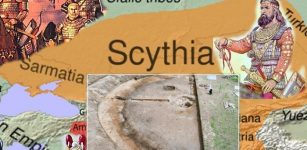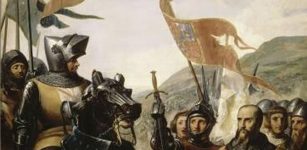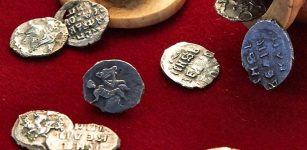Hnefatafl: Ancient Viking Board Game “King’s Table” Popular In Medieval Scandinavia
Ellen Lloyd - AncientPages.com - Hnefatafl or tafl was an ancient Viking board game that became very popular in medieval Scandinavia. The Vikings played board games as early as 400 A.D. Hnefatafl was a war strategy game.
Viking chess hnefatafl on a carved board made of dark wood. Credit: Olga Makukha - Adobe Stock
The name means "King's Table," and although no description of the rules of the Hnefatafl exists, we know the game resembled chess, at least to some extent.
The king aimed to escape to the board's periphery or corners, while the greater force aimed to capture him. The attacking force has the natural advantage at the start of each game, likely indicating an essential cultural aspect by mimicking the success of Viking raids.
Vikings brought the board game to the lands they conquered, and eventually, the Hnefatafl became popular in other countries such as Ireland, Britain, Wales, and Iceland. Archaeological discoveries reveal the game was even popular in Ukraine.
The reconstructed Hnefatafl gameboard. Image credit: Andreas Zautner - Public Domain
In ancient times, board games were as popular as today. Board games were standard in ancient Egypt, Mesopotamia, and other parts of the world.
The Royal Game Of Ur played in Mesopotamia is at least 4,400 years old! It is widely considered one of the oldest game boards ever discovered. Board games such as Senet were widespread in ancient Egypt, and people from all levels of society played them.
The Vikings did not differ from other ancient civilizations. They, too, enjoyed board games.
Very little was known about the Viking board game for quite some time. Hnefatafl was mentioned in several medieval sagas, including the Orkneyinga saga, Friðþjófs saga, and Hervarar saga.
The earliest mention of the game appears in Vôluspa 60:
"Then in the grass, the golden taeflor ("table-men"),
the far-famed ones,
which they had owned in older days, will be found again."[8]
Both men and women played Hnefatafl. The Viking board is depicted on runestones.
The Ockelbo Runestone, Sweden, depicts two people playing the Hnefatafl. Image source
One runestone from Ockelbo, Sweden, shows two men balancing a board game on their knees. The image reflects the saga references where arguments over the game frequently cause one or both players to leap to their feet, upsetting the tafl-board and scattering the pieces.
Fragments of actual game boards have been excavated. One board discovered on the Viking ship Gokstad has a 15 × 15 ruled board on one side for tafl and what appears to be a nine-men-morris board (O.N. mylta, "mills") on the reverse side.
Hnefatafl was famous for a long time. In the 11th century, as chess grew in popularity, the magnificent ancient Viking board game became more or less forgotten. Only people living in remote areas played it.
Hnefatafl was last recorded as being played in Wales in 1587 and in Lappland in 1723.
Written by - Ellen Lloyd – AncientPages.com
Updated on January 17, 2024
Copyright © AncientPages.com All rights reserved. This material may not be published, broadcast, rewritten or redistributed in whole or part without the express written permission of AncientPages.com
Expand for referencesMore From Ancient Pages
-
 Water Storage Failure And Short-Lived Koh Ker Capital Of Khmer Empire
Archaeology | Nov 1, 2019
Water Storage Failure And Short-Lived Koh Ker Capital Of Khmer Empire
Archaeology | Nov 1, 2019 -
 Was Princess Tadukhipa Of The Mitanni Kingdom Queen Nefertiti?
Civilizations | Mar 15, 2016
Was Princess Tadukhipa Of The Mitanni Kingdom Queen Nefertiti?
Civilizations | Mar 15, 2016 -
 Ancient ‘iPhone-Like’ Artifact Discovered At The Russian Atlantis
Archaeology | Sep 10, 2019
Ancient ‘iPhone-Like’ Artifact Discovered At The Russian Atlantis
Archaeology | Sep 10, 2019 -
 Neanderthals: The Oldest Art In The World Wasn’t Made By Humans
Featured Stories | Jan 17, 2023
Neanderthals: The Oldest Art In The World Wasn’t Made By Humans
Featured Stories | Jan 17, 2023 -
 Surtshellir Cave Reveals How Vikings Attempted To Prevent Ragnarök – Doom Of The Gods
Vikings | Jul 17, 2023
Surtshellir Cave Reveals How Vikings Attempted To Prevent Ragnarök – Doom Of The Gods
Vikings | Jul 17, 2023 -
 2,500-Year-Old Scythian Warrior Found In Untouched Grave In Siberian ‘Valley Of The Kings’
Archaeology | Jan 7, 2020
2,500-Year-Old Scythian Warrior Found In Untouched Grave In Siberian ‘Valley Of The Kings’
Archaeology | Jan 7, 2020 -
 Nygrotta: Species Migration Occurred Due To Climatic Shifts Millennia Ago – Ancient DNA And Bones Show
Paleontology | Apr 5, 2024
Nygrotta: Species Migration Occurred Due To Climatic Shifts Millennia Ago – Ancient DNA And Bones Show
Paleontology | Apr 5, 2024 -
 Thousand Unearted Artifacts Reveal ‘Major’ Ancient Migration To Timor Island
Archaeology | May 23, 2024
Thousand Unearted Artifacts Reveal ‘Major’ Ancient Migration To Timor Island
Archaeology | May 23, 2024 -
 Silver And Bronze Coins Discovered In Ancient Roman Fort Apsaros, Georgia
Archaeology | Jul 23, 2018
Silver And Bronze Coins Discovered In Ancient Roman Fort Apsaros, Georgia
Archaeology | Jul 23, 2018 -
 Vikings: Facts And History About The Tough Norse Seafaring People
Ancient History Facts | Mar 13, 2017
Vikings: Facts And History About The Tough Norse Seafaring People
Ancient History Facts | Mar 13, 2017 -
 Frigg: Chief Norse Goddess Who Knew Secrets Of Humans’ Fates
Featured Stories | Dec 13, 2022
Frigg: Chief Norse Goddess Who Knew Secrets Of Humans’ Fates
Featured Stories | Dec 13, 2022 -
 Man-Made Square Burial Cave Dated To Rameses II-Era Accidentally Found In Israel
Archaeology | Sep 19, 2022
Man-Made Square Burial Cave Dated To Rameses II-Era Accidentally Found In Israel
Archaeology | Sep 19, 2022 -
 Historians Search For A Frightening Ancient Underground Secret In One Of Tampa Bay’s Cities
Featured Stories | Sep 1, 2024
Historians Search For A Frightening Ancient Underground Secret In One Of Tampa Bay’s Cities
Featured Stories | Sep 1, 2024 -
 Bertrand du Guesclin: ‘Eagle Of Brittany’ Brave, French Commander And His Clash With Sir Thomas Of Canterbury
Featured Stories | May 1, 2023
Bertrand du Guesclin: ‘Eagle Of Brittany’ Brave, French Commander And His Clash With Sir Thomas Of Canterbury
Featured Stories | May 1, 2023 -
 Bizarre Meat-Eating Dinosaur Found In Classic Fossil Site In Egypt’s Sahara Desert
Archaeology | Jun 9, 2022
Bizarre Meat-Eating Dinosaur Found In Classic Fossil Site In Egypt’s Sahara Desert
Archaeology | Jun 9, 2022 -
 The Inca Empire Was Powerful And Well-Organized – Why Were They So Successful?
Ancient History Facts | Sep 21, 2020
The Inca Empire Was Powerful And Well-Organized – Why Were They So Successful?
Ancient History Facts | Sep 21, 2020 -
 Silver Coins Hidden In Chess Figure Date Back To Ivan The Terrible’s Days – Discovery In Moscow
Archaeology | May 13, 2017
Silver Coins Hidden In Chess Figure Date Back To Ivan The Terrible’s Days – Discovery In Moscow
Archaeology | May 13, 2017 -
 World’s Oldest Mercury Poisoning Revealed In Copper Age Iberia
Archaeology | Nov 16, 2021
World’s Oldest Mercury Poisoning Revealed In Copper Age Iberia
Archaeology | Nov 16, 2021 -
 Cimmerians – Ancient People Searching For A Home
Civilizations | Feb 11, 2019
Cimmerians – Ancient People Searching For A Home
Civilizations | Feb 11, 2019 -
 Burial Chamber Of Ankhesenamun, Tutankhamun’s Wife May Soon Be Found
Archaeology | Jan 22, 2018
Burial Chamber Of Ankhesenamun, Tutankhamun’s Wife May Soon Be Found
Archaeology | Jan 22, 2018



